We undoubtedly entered southern India with our flight to Kochi. It was still India, but it didn’t feel the same. Nothing huge – instead, it was a lots of little things that added up, amounting to a noticeably different experience. Roads were smoother. Less trash on the streets. More plants and lush greenery around. People seemed more chill – fewer crowds, less shouting. The city was more spread out. The buildings looked more like Spanish villas than cement blocks. The pace was calmer. Ah, yes, we’re definitely about to see a different side of India here in Kerala.
Fort Kochi
A historic area in the city of Kochi, Fort Kochi was located on an island off the mainland region of Ernakulam. That’s probably why it felt even more laid-back. With narrow roads and colonial buildings not far from the water, there were barely any vehicles around. It couldn’t be a further cry from the large urban sprawl of Delhi or the chaos of Varanasi.

Once belonging to the Portuguese, Fort Kochi was later taken by the Dutch, then the British, each controlling for more than a hundred years. With Indian independence, the territory was back in local hands. Nevertheless, evidence of colonialism remains today, from the Santa Cruz Basilica to the St. Francis Church.
Ironically, one of the most popular tourist sights in the area was not at all European – the Chinese fishing nets. They’re essentially large wooden structures fixed on shore, with large nets that can be raised or lowered via ropes into the water. A team of fisherman operated each one, leaving the net in the water briefly before hauling in their catch. For such a big contraption, you’d think they would get lots of fish, but that’s usually not the case. Sometimes we saw a few fish, sometimes we saw nothing. I think they’re an attraction just because the practice was unusual for India and they’re arguably quite photogenic.

Just walking around was pleasant. After a month in India, I can’t tell you how enjoyable it was to have a calm, quiet, undisturbed stroll through the streets. No cars, no cows, no honks. No one crowding us, heckling us, following us. I never noticed how distracting all of those things usually were in India. Here, we could actually look around. We saw many children and families in a local playground. We walked past the nearby beach – Mahatma Gandhi beach – and were not too impressed (but we do have high standards for that by now). We also heard that the only Jewish synagogue in all of India was nearby, though we did not go to see it in person.

While all of that was nice enough, we were most looking forward to a boat ride.
Kerala Backwaters
The best part of Kerala was arguably its backwaters. A network of waterways, the backwaters were rivers, canals, and lakes, all interconnected. The best way to explore this labyrinth was to cruise in a Kerala houseboat. Apparently common for Indian honeymooners, the fancy Kerala houseboats have private rooms with AC, a chef on board, a deck and dining area. We didn’t need to spend the night and were happy to just take a day tour through the backwaters.

Our boat was much more of an average boat as compared to the fancy ones I just mentioned, but only in amenities. Each one of us just had a chair under the roof cover. However, the boat itself had a very distinct Kerala houseboat look. Wooden hulls and bamboo sticks all tied together with thick rope. It looked more like a cute little wooden cottage with rounded windows and doors floating on the water than an actual boat.

To make things even more interesting, the boat was entirely powered by hand. Two boatmen with very long bamboo sticks manually pushed the boat against the bottom. Needless to say, the boat did not move very fast, but that was part of the experience. The whole point was to slowly cruise through the backwater as time seemed to stand still. It was by far the most relaxing tour or cruise we had ever been on and probably will ever be on.

Many plants and wildlife inhabited the backwaters. While we noticed several water birds and aquatic life, one plant in particular was common – odollam. Along the waterways, tantalizing green fruits hung from the trees, which I thought looked like green mangoes. It turns out they are highly poisonous; cerberin in the odollam seeds stops heart functions. Many people use it as a means of suicide or murder, especially since it’s easily obtainable and free. It’s scary to think how easy it would be to mistake it for a fruit and accidentally poison oneself.

There were pitstops along the way to observe local livelihoods. Shells and byproduct of petrol were heated and grounded together to form a sort of white cement base. Coconut hairs were dried and spun into ropes – the same ones that held our boat together and made the carpeted floors. Palm sap can be extracted for palm toddy, or palm wine. Just like every other time we’ve visited locals in rural areas (like Sapa or Inle Lake), I was amazed by their resourcefulness and hard work.

We had lunch on one of the local islands, and got a taste of the flavours of Kerala. I can’t say I knew what exactly we were served, but it seemed very homey and authentic. Instead of a plate, we each had a piece of banana leaf, upon which portions of vegetarian dishes were served. There was rice and potato curry, a mix of vegetables, a side of spicy pickle, and a papad. Coconut cream with sago for dessert.

The rest of the afternoon we spent cruising through Ashtamudi Lake. As scenic as it was, no one remembered much, because everyone on the boat at some point fell asleep. It was simply too soothing and calm after a meal to stay alert. All that was missing was a nice hammock, and then it would really have been perfect.

After all the chaos, commotion, and dry heat of our past month in northern India, this was significant change. I never would have thought that this facet of India existed, had I not personally experienced it for myself. It just goes to show that the country is as diverse as we suspected all along. Too bad we didn’t spend more time in southern India – next time, we know what we’re missing.
For more pictures from Kochi, please visit the gallery!
